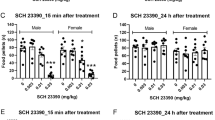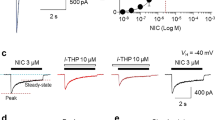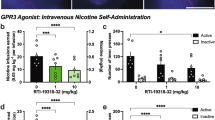Abstract
Environmental stimuli previously paired with drug taking appear to play a critical role in nicotine dependence. Converging anatomical, pharmacological, and behavioral evidence implicates dopamine D3 receptors (D3Rs) in the mechanisms underlying stimulus-controlled drug-seeking behavior. This study assessed the effects of BP 897, a D3R partial agonist and ST 198, a D3R antagonist, on nicotine-induced conditioned place preferences (CPPs), used as a measure of drug-seeking behavior, on food-maintained responding and on discrimination performance under a two-lever-choice nicotine discrimination procedure. BP 897 and ST 198 both blocked the expression of nicotine-induced CPP at doses selective for D3R. They had no effect on locomotor activity in the CPP apparatus and no significant effect on nicotine discrimination performance or food-maintained responding under the discrimination procedure. Involvement of antidepressant actions in the effects of BP 897 and ST 198 on CPP is unlikely, since we found no effect of D3R blockade with BP 897 or genetic depletion of D3Rs in a forced swimming test, used as a behavioral test for antidepressant activity. This suggests that D3R ligands reduce the motivational effects of nicotine by a mechanism distinct from those of nicotine replacement therapy and bupropion, the two currently used aids for smoking cessation in humans. These findings support the use of D3R ligands as aids for smoking cessation and indicate that their effects would be selective for those rewarding or reinforcing effects of nicotine that contribute to the maintenance of tobacco-smoking behavior, without affecting subjective responses to nicotine or producing any antidepressant-like effects.
Similar content being viewed by others
Log in or create a free account to read this content
Gain free access to this article, as well as selected content from this journal and more on nature.com
or
References
Accili D, Fishburn CS, Drago J, Steiner H, Lachowicz JE, Park B-H et al (1996). A targeted mutation of the D3 receptor gene is associated with hyperactivity in mice. Proc Natl Acad Sci USA 93: 1945–1949.
Acquas E, Carboni E, Leone P, Di Chiara G (1989). SCH 23390 blocks drug-conditioned place-preference and place-aversion: anhedonia (lack of reward) or apathy (lack of motivation) after dopamine-receptor blockade? Psychopharmacology (Berl) 99: 151–155.
Andreoli M, Tessari M, Pilla M, Valerio E, Hagan JJ, Heidbreder CA (2003). Selective antagonism at dopamine D3 receptors prevents nicotine-triggered relapse to nicotine-seeking behavior. Neuropsychopharmacology 28: 1272–1280.
Ashby Jr CR, Paul M, Gardner EL, Heidbreder CA, Hagan JJ (2003). Acute administration of the selective D3 receptor antagonist SB-277011A blocks the acquisition and expression of the conditioned place preference response to heroin in male rats. Synapse 48: 154–156.
Bezard E, Ferry S, Mach U, Stark H, Leriche L, Boraud T et al (2003). Attenuation of levodopa-induced dyskinesia by normalizing dopamine D(3) receptor function. Nat Med 9: 762–767.
Bouthenet ML, Souil E, Martres M-P, Sokoloff P, Giros B, Schwartz J-C (1991). Localization of dopamine D3 receptor mRNA in the rat brain using in situ hybridization histochemistry: comparison with D2 receptor mRNA. Brain Res 564: 203–219.
Caggiula AR, Donny EC, Chaudhri N, Perkins KA, Evans-Martin FF, Sved AF (2002a). Importance of nonpharmacological factors in nicotine self-administration. Physiol Behav 77: 683–687.
Caggiula AR, Donny EC, White AR, Chaudhri N, Booth S, Gharib MA et al (2001). Cue dependency of nicotine self-administration and smoking. Pharmacol Biochem Behav 70: 515–530.
Caggiula AR, Donny EC, White AR, Chaudhri N, Booth S, Gharib MA et al (2002b). Environmental stimuli promote the acquisition of nicotine self-administration in rats. Psychopharmacology (Berl) 163: 230–237.
Calcagnetti DJ, Schechter MD (1994). Nicotine place preference using the biased method of conditioning. Prog Neuropsychopharmacol Biol Psychiatry 18: 925–933.
Childress AR, Mozley PD, McElgin W, Fitzgerald J, Reivich M, O'Brien CP (1999). Limbic activation during cue-induced cocaine craving. Am J Psychiatry 156: 11–18.
Colpaert FC (1999). Drug discrimination in neurobiology. Pharmacol Biochem Behav 64: 337–345.
Cooper BR, Hester TJ, Maxwell RA (1980). Behavioral and biochemical effects of the antidepressant bupropion (Wellbutrin): evidence for selective blockade of dopamine uptake in vivo. J Pharmacol Exp Ther 215: 127–134.
Desai RI, Barber DJ, Terry P (2003). Dopaminergic and cholinergic involvement in the discriminative stimulus effects of nicotine and cocaine in rats. Psychopharmacology (Berl) 167: 335–343.
Di Ciano P, Blaha CD, Phillips AG (1998a). Conditioned changes in dopamine oxidation currents in the nucleus accumbens of rats by stimuli paired with self-administration or yoked-administration of d-amphetamine. Eur J Neurosci 10: 1121–1127.
Di Ciano P, Blaha CD, Phillips AG (1998b). The relation between dopamine oxidation currents in the nucleus accumbens and conditioned increases in motor activity in rats following repeated administration of d-amphetamine or cocaine. Eur J Neurosci 10: 1113–1120.
Di Ciano P, Underwood RJ, Hagan JJ, Everitt BJ (2003). Attenuation of cue-controlled cocaine-seeking by a selective D3 dopamine receptor antagonist SB-277011-A. Neuropsychopharmacology 28: 329–338.
Diaz J, Lévesque D, Lammers CH, Griffon N, Martres MP, Schwartz J-C et al (1995). Phenotypical characterization of neurons expressing the dopamine D3 receptor. Neuroscience 65: 731–745.
Diaz J, Pilon C, Le Foll B, Gros C, Triller A, Schwartz JC et al (2000). Dopamine D3 receptors expressed by all mesencephalic dopamine neurons. J Neurosci 20: 8677–8684.
Duarte C, Lefebvre C, Chaperon F, Hamon M, Thiebot MH (2003). Effects of a dopamine D3 receptor ligand, BP 897, on acquisition and expression of food-, morphine-, and cocaine-induced conditioned place preference, and food-seeking behavior in rats. Neuropsychopharmacology 28: 1903–1915.
Fiore MC, Bailey WC, Cohen SJ, Dorfman SF, Goldstein MG, Gritz ER (2000). Treating Tobacco Use and Dependence. Clinical Practice Guideline. US Department of Health and Human Service, Public Health Service: Rockville, MD, USA.
Francès H, Le Foll B, Diaz J, Smirnova M, Sokoloff P (2004a). Role of DRD3 in morphine-induced conditioned place preference using drd3-knockout mice. Neuroreport 15: 2245–2249.
Francès H, Smirnova M, Leriche L, Sokoloff P (2004b). Dopamine D(3) receptor ligands modulate the acquisition of morphine-conditioned place preference. Psychopharmacology (Berl) 175: 127–133.
Gasior M, Jaszyna M, Munzar P, Witkin JM, Goldberg SR (2002). Caffeine potentiates the discriminative-stimulus effects of nicotine in rats. Psychopharmacology (Berl) 162: 385–395.
Goldberg SR (1973). Comparable behavior maintained under fixed-ratio and second-order schedules of food presentation, cocaine injection or d-amphetamine injection in the squirrel monkey. J Pharmacol Exp Ther 186: 18–30.
Goldberg SR, Gardner ML (1981). Second-order schedules: extended sequences of behavior controlled by brief environmental stimuli associated with drug self-administration. NIDA Res Monogr 37: 241–270.
Goldberg SR, Spealman RD, Goldberg DM (1981). Persistent behavior at high rates maintained by intravenous self-administration of nicotine. Science 214: 573–575.
Gyertyan I, Gal K (2003). Dopamine D3 receptor ligands show place conditioning effect but do not influence cocaine-induced place preference. Neuroreport 14: 93–98.
Imperato A, Mulas A, Di Chiara G (1986). Nicotine preferentially stimulates dopamine release in the limbic system of freely moving rats. Eur J Pharmacol 132: 337–338.
Ito R, Dalley JW, Howes SR, Robbins TW, Everitt BJ (2000). Dissociation in conditioned dopamine release in the nucleus accumbens core and shell in response to cocaine cues and during cocaine-seeking behavior in rats. J Neurosci 20: 7489–7495.
Koob GF (1992). Dopamine, addiction and reward. Sem Neurosci 4: 139–148.
Lammers CH, Diaz J, Schwartz JC, Sokoloff P (2000). Selective increase of dopamine D3 receptor gene expression as a common effect of chronic antidepressant treatments. Mol Psychiatry 5: 378–388.
Lattanzi L, Dell'Osso L, Cassano P, Pini S, Rucci P, Houck PR et al (2002). Pramipexole in treatment-resistant depression: a 16-week naturalistic study. Bipolar Disord 4: 307–314.
Le Foll B, Diaz J, Sokoloff P (2003a). Increased dopamine D3 receptor expression accompanying behavioural sensitization to nicotine in rats. Synapse 47: 176–183.
Le Foll B, Diaz J, Sokoloff P (2004). Neuroadaptations to hyperdopaminergia in dopamine D3 receptor deficient mice. Life Sci, in press.
Le Foll B, Francès H, Diaz J, Schwartz J-C, Sokoloff P (2002). Role of the dopamine D3 receptor in reactivity to cocaine-associated cues in mice. Eur J Neurosci 15: 2016–2026.
Le Foll B, Goldberg SR (2004a). Nicotine induces conditioned place preferences over a large range of doses in rats. Psychopharmacology (Berl), in press.
Le Foll B, Goldberg SR (2004b). Rimonabant, a CB1 antagonist, blocks nicotine-conditioned place preferences. Neuroreport 15: 2139–2143.
Le Foll B, Schwartz J-C, Sokoloff P (2000). Dopamine D3 receptor agents as potential new medications for drug addiction. Eur Psychiatry 15: 140–146.
Le Foll B, Schwartz J-C, Sokoloff P (2003b). Disruption of nicotine conditioning by dopamine D3 receptor ligands. Mol Psychiatry 8: 225–230.
Leriche L, Schwartz JC, Sokoloff P (2003). The dopamine D3 receptor mediates locomotor hyperactivity induced by NMDA receptor blockade. Neuropharmacology 45: 174–181.
Levant B (1997). The D3 dopamine receptor: neurobiology and potential clinical relevance. Pharmacol Rev 49: 231–252.
Mach UR, Hackling AE, Perachon S, Ferry S, Wermuth CG, Schwartz J-C et al (2004). Development of novel 1,2,3,4-tetrahydroisoquinoline derivatives and closely related compounds as potent and selective dopamine D3 receptor ligands. Chem BioChem 5: 508–518.
Maj J, Rogoz Z, Skuza G, Kolodziejczyk K (1997). Antidepressant effects of pramipexole, a novel dopamine receptor agonist. J Neural Transm 104: 525–533.
Ostow M (2002). Pramipexole for depression. Am J Psychiatry 159: 320–321.
Phillips PE, Stuber GD, Heien ML, Wightman RM, Carelli RM (2003). Subsecond dopamine release promotes cocaine seeking. Nature 422: 614–618.
Pidoplichko VI, DeBiasi M, Williams JT, Dani JA (1997). Nicotine activates and desensitizes midbrain dopamine neurons. Nature 390: 401–404.
Pilla M, Perachon S, Sautel F, Garrido F, Mann A, Wermuth CG et al (1999). Selective inhibition of cocaine-seeking behaviour by a partial dopamine D3 receptor agonist. Nature 400: 371–375.
Porsolt RD, Anton G, Blavet N, Jalfre M (1978). Behavioral despair in rats: a new model sensitive to antidepressant treatments. Eur J Pharmacol 47: 379–391.
Porsolt RD, Bertin A, Jalfre M (1977). Behavioral despair in mice: a primary screening test for antidepressants. Arch Int Pharmacodyn Ther 229: 327–336.
Reavill C, Taylor SG, Wood MD, Ashmeade T, Austin NE, Avenell KY et al (2000). Pharmacological actions of a novel, high-affinity, and selective human dopamine D(3) receptor antagonist, SB-277011-A. J Pharmacol Exp Ther 294: 1154–1165.
Renard CE, Fiocco AJ, Clenet F, Hascoet M, Bourin M (2001). Is dopamine implicated in the antidepressant-like effects of selective serotonin reuptake inhibitors in the mouse forced swimming test? Psychopharmacology (Berl) 159: 42–50.
Robinson TE, Berridge KC (1993). The neural basis of drug craving: an incentive-sensitization theory of addiction. Brain Res Rev 18: 247–291.
Rogoz Z, Skuza G, Klodzinska A (2003). Anxiolytic-like effects of preferential dopamine D3 receptor agonists in an animal model. Pol J Pharmacol 55: 449–454.
Schuster CR, Woods JH (1968). The conditioned reinforcing effects of stimuli associated with morphine reinforcement. Int J Addict 3: 223–230.
Segal DM, Moraes CT, Mash DC (1997). Up-regulation of D3 dopamine receptor mRNA in the nucleus accumbens of human cocaine fatalities. Mol Brain Res 45: 335–339.
Shoaib M, Thorndike E, Schindler CW, Goldberg SR (1997). Discriminative stimulus effects of nicotine and chronic tolerance. Pharmacol Biochem Behav 56: 167–173.
Sokoloff P, Giros B, Martres M-P, Bouthenet M-L, Schwartz J-C (1990). Molecular cloning and characterization of a novel dopamine receptor (D3) as a target for neuroleptics. Nature 347: 146–151.
Staley JK, Mash DC (1996). Adaptive increase in D3 dopamine receptors in the brain reward circuits of human cocaine fatalities. J Neurosci 16: 6100–6106.
Steru L, Chermat R, Thierry B, Simon P (1985). The tail suspension test: a new method for screening antidepressants in mice. Psychopharmacology (Berl) 85: 367–370.
Stewart J, de Wit H, Eikelboom R (1984). Role of unconditioned and conditioned drug effects in the self-administration of opiates and stimulants. Psychol Rev 91: 251–268.
Vorel SR, Ashby CRJ, Paul M, Liu X, Hayes R, Hagan JJ et al (2002). Dopamine D3 receptor antagonism inhibits cocaine-seeking and cocaine-enhanced brain reward in rats. J Neurosci 22: 9595–9603.
Weiss F, Maldonado-Vlaar CS, Parsons LH, Kerr TM, Smith DL, Ben-Shahar O (2000). Control of cocaine-seeking behavior by drug-associated stimuli in rats: effects on recovery of extinguished operant-responding and extracellular dopamine levels in amygdala and nucleus accumbens. Proc Natl Acad Sci USA 97: 4321–4326.
Weissenborn R, Deroche V, Koob GF, Weiss F (1996). Effects of dopamine agonists and antagonists on cocaine-induced operant responding for a cocaine-associated stimulus. Psychopharmacology (Berl) 126: 311–322.
Wiley JL, Lavecchia KL, Martin BR, Damaj MI (2002). Nicotine-like discriminative stimulus effects of bupropion in rats. Exp Clin Psychopharmacol 10: 129–135.
Willner P (1997). The mesolimbic dopamine system as a target for rapid antidepressant action. Int Clin Psychopharmacology 12 (Suppl 3): S7–S14.
Wise RA, Rompre PP (1989). Brain dopamine and reward. Annu Rev Psychol 40: 191–225.
Yasar S, Bergman J (1994). Amphetamine-like effect of l-deprenyl (selegiline) in drug discrimination studies. Clin Pharmacol Ther 56: 768–773.
Young R, Glennon RA (2002). Nicotine and bupropion share a similar discriminative stimulus effect. Eur J Pharmacol 443: 113–118.
Zocchi A, Varnier G, Arban R, Griffante C, Zanetti L, Bettelini L et al (2003). Effects of antidepressant drugs and GR 205171, an neurokinin-1 (NK1) receptor antagonist, on the response in the forced swim test and on monoamine extracellular levels in the frontal cortex of the mouse. Neurosci Lett 345: 73–76.
Acknowledgements
This study was supported by the Intramural Research Program (S Goldberg and B Le Foll, Principal Investigators) of the National Institute on Drug Abuse, NIH, DHHS. BLF is a visiting fellow at NIDA and his move to NIDA was supported by the Gilbert Lagrue Foundation and the Simone and Cino del Duca Foundation. We thank Pr M Bourin for the training in the forced swimming test. We thank Carrie Wertheim and Dan Otten for technical assistance and Eric Thorndike for the programming.
Author information
Authors and Affiliations
Corresponding author
Rights and permissions
About this article
Cite this article
Le Foll, B., Sokoloff, P., Stark, H. et al. Dopamine D3 Receptor Ligands Block Nicotine-Induced Conditioned Place Preferences through a Mechanism that does not Involve Discriminative-Stimulus or Antidepressant-Like Effects. Neuropsychopharmacol 30, 720–730 (2005). https://doi.org/10.1038/sj.npp.1300622
Received:
Revised:
Accepted:
Published:
Issue date:
DOI: https://doi.org/10.1038/sj.npp.1300622
Keywords
This article is cited by
-
Dopamine D3 Receptors in the Basolateral Amygdala and the Lateral Habenula Modulate Cue-Induced Reinstatement of Nicotine Seeking
Neuropsychopharmacology (2014)
-
Elevation of Dopamine Induced by Cigarette Smoking: Novel Insights from a [11C]-(+)-PHNO PET Study in Humans
Neuropsychopharmacology (2014)
-
Effects of Chronic Buspirone Treatment on Nicotine and Concurrent Nicotine+Cocaine Self-Administration
Neuropsychopharmacology (2013)
-
Mechanism-based medication development for the treatment of nicotine dependence
Acta Pharmacologica Sinica (2009)
-
The dopamine D3 receptor partial agonist CJB 090 inhibits the discriminative stimulus but not the reinforcing or priming effects of cocaine in squirrel monkeys
Psychopharmacology (2009)



